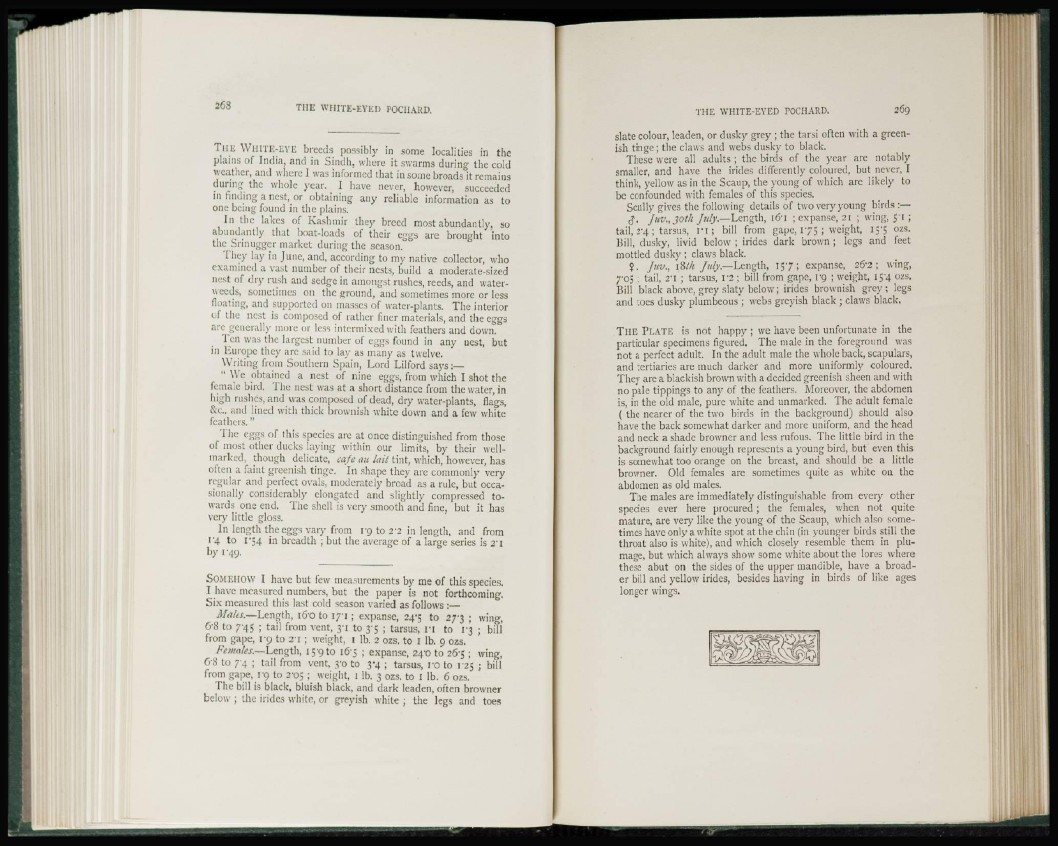
268 THE WHITE-EYED POCHARD.
THE WHITE-EYE breeds possibly in some localities in the
plains of India, and in Sindh, where it swarms during the cold
weather, and where I was informed that in some broads it remains
during the whole year. I have never, however, succeeded
in finding a nest, or obtaining any reliable information as to
one being found in the plains.
In the lakes of Kashmir they breed most abundantly, so
abundantly that boat-loads of their eggs are brought into
the Srinugger market during the season.
They lay in June, and, according lo my native collector, who
examined a vast number of their nests, build a moderate-sized
nest of dry rush and sedge in amongst rushes, reeds, and waterweeds,
sometimes on the ground, and sometimes more or less
floating, and supported on masses of water-plants. The interior
of the nest is composed of rather finer materials, and the eggs
are generally more or less intermixed with feathers and down.
Ten was the largest number of eggs found in any nest, but
in Europe they arc said to lay as many as twelve.
Writing from Southern Spain, Lord Lilford says:—
" We obtained a nest of nine eggs, from which I shot the
female bird. The nest was at a short distance from the water, in
high rushes, and was composed of dead, dry water-plants, flags,
&C and lined with thick brownish white down and a few white
feathers."
The eggs of this species are at once distinguished from those
of most other ducks laying within our limits, by their wellmarked,
though delicate, cafe an lait tint, which, however, has
often a faint greenish tinge. In shape they are commonly very
regular and perfect ovals, moderately broad as a rule, but occasionally
considerably elongated and slightly compressed towards
one end. The shell is very smooth and fine, but it has
very little gloss.
In length the eggs vary from 1*9 to 2-2 in length, and from
1'4 to i"54 in breadth ; but the average of a large series is 2'i
by 149.
SOMEHOW I have but few measurements by me of this species.
I have measured numbers, but the paper is not forthcoming.
Six measured this last cold season varied as follows :—
Malts.—Length, i&o to i y i ; expanse, 24-5 to 27-3 ; wing,
G*8 to 7-45 ; tail from vent, 3"i to 3*5 ; tarsus, 1*1 to 1*3 ; bill
from gape, 1*9 to 2*1 ; weight, 1 lb. 2 ozs. to 1 lb. 9 ozs.
Females.—Length, i5'9to 165 ; expanse, 24*0 to 26-5 ; wing,
63 to 74 ; tail from vent, 3*0 to 3-4 ; tarsus, ro to 1-25 ; bill
from gape, 1*9 to 2-05 ; weight, 1 lb. 3 ozs. to I lb. 6 ozs.
The bill h black, bluish black, and dark leaden, often browner
below ; the hides white, or greyish white ; the legs and toes
THE WHITE-EYED POCHARD. 269
slate colour, leaden, or dusky grey ; the tarsi often with a greenish
tinge ; the claws and webs dusky to black.
These were all adults ; the birds of the year are notably
smaller, and have the irides differently coloured, but never, I
think, yellow as in the Scaup, the young of which arc likely to
be confounded with females of this species.
Scully gives the following details of two very young birds :—
0*. Jnv., jot/t July.—Length, I6T ; expanse, 21 ; wing, 51 ;
tail, 2*4 ; tarsus, I T ; bill from gape, i'7$ ; weight, 15*5 ozs.
Bill, dusky, livid below ; irides dark brown; legs and feet
mottled dusky ; claws black.
°. Juv., July.—Length, 157 ; expanse, 26*2 ; wing,
7*05 ; tail, 2*1 ; tarsus, i-2 ; bill from gape, rg ; weight, 15*4 ozs.
Bill black above, grey slaty below; irides brownish grey; legs
and toes dusky plumbeous ; webs greyish black ; claws black.
THE PLATE is not happy ; we have been unfortunate in the
particular specimens figured. The male in the foreground was
not a perfect adult. In the adult male the whole back, scapulars,
and tertiaries are much darker and more uniformly coloured.
They are a blackish brown with a decided greenish sheen and with
no pale tippings to any of the feathers. Moreover, the abdomen
is, in the old male, pure white and unmarked. The adult female
( the nearer of the two birds in the background) should also
have the back somewhat darker and more uniform, and the head
and neck a shade browner and less rufous. The little bird in the
background fairly enough represents a young bird, but even this
is somewhat too orange on the breast, and should be a little
browner. Old females are sometimes quite as white on the
abdomen as old males.
The males arc immediately distinguishable from every other
species ever here procured ; the females, when not quite
mature, are very like the young of the Scaup, which also sometimes
have only a white spot at the chin (in younger birds still the
throat also is white), and which closely resemble them in plumage,
but which always show some white about the lores where
these abut on the sides of the upper mandible, have a broader
bill and yellow irides, besides having in birds of like ages
longer wings.